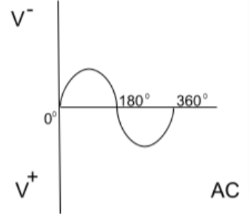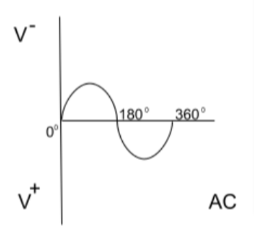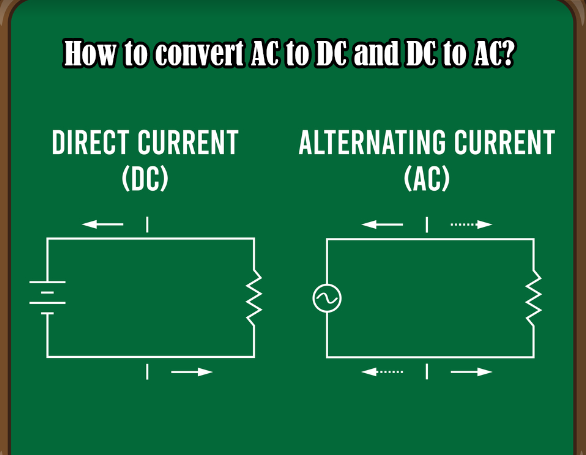AC and DC are used widely in physics. AC stands for alternating current while DC stands for direct current. AC and DC are the types of electric current flow.
In this article, we will learn about the definition of AC and DC, the conversion of AC and DC & DC to AC along a lot of examples. We shall also discuss the applications of AC and DC also the difference between AC and DC.
What are AC and DC?
AC stands for alternating current and is defined as the electric current which periodically reverses direction and changes its magnitude continuously with time. It can also be defined as the electric charge changing the direction periodically. SI unit is volt-amperes.

DC stands for direct currentand is defined as an electric current that has the same direction and magnitude all the time. It is also defined as the electric charge that flows in one direction. SI unit is volt-amperes.

How to convert AC to DC?
To convert alternating current in the direct current we use formula,
DC = 0.636 x AC
Here, AC = Alternating current, DC = Direct current, and 0.636 = constant. To get the accurate results, you can use AC to DC Calculator.
Let us take some examples in order to understand this conversion.
Example 1
Convert alternating current to direct current if AC = 275 volts?
Solution
Step 1:write down the formula.
DC = 0.636 x AC
Step 2:Put the value of AC in the formula.
DC = 0.636 x AC
DC = 0.636 x 275
DC = 174.9 volts
Example 2
Convert alternating current to direct current if AC = 2670 volts?
Solution
Step 1:write down the formula.
DC = 0.636 x AC
Step 2:Put the value of AC in the formula.
DC = 0.636 x AC
DC = 0.636 x 2670
DC = 1698.12 volts
Example 3
Convert alternating current to direct current if AC = 0.2670 volts?
Solution
Step 1:write down the formula.
DC = 0.636 x AC
Step 2:Put the value of AC in the formula.
DC = 0.636 x AC
DC = 0.636 x 0.2670
DC = 0.169812 volts
How to convert DC to AC?
To convert direct current in alternating current we use formula,
AC = DC / 0.636
Here, AC = Alternating current, DC = Direct current, and 0.636 = constant.
Let us take some examples in order to understand this conversion.
Example 1
Convert direct current in the alternating current if DC = 75 volts?
Solution
Step 1:write down the formula.
AC = DC / 0.636
Step 2:Put the value of DC in the formula.
AC = DC / 0.636
AC = 75 / 0.636
AC = 117.92 volts
Example 2
Convert direct current in the alternating current if DC = 6270 volts?
Solution
Step 1:write down the formula.
AC = DC / 0.636
Step 2:Put the value of DC in the formula.
AC = DC / 0.636
AC = 6270 / 0.636
AC = 9858.49 volts
Example 3
Convert direct current in the alternating current if DC = 0.2670 volts?
Solution
Step 1:write down the formula.
AC = DC / 0.636
Step 2:Put the value of AC in the formula.
AC = DC / 0.636
AC = 0.2670 / 0.636
DC = 0.4198 volts
Difference between AC and DC
- In Ac,currentmodifications its pathduring flow whilein DC,current does now no longermodifications its pathduring flow and staysconstant.
- The AC has a frequency that suggests how generally the path of current flow changes during flow while the frequency of the direct current is 0because it doesnot change the path of flow.
- The electricityelement of AC is zeroto at least onewhile DC is Constant Zero.
- The AC is generated via (by) the alternator whilst DC is generated via Photovoltaic cells, generators, and batteries.
- The AC load may be capacitive, inductive, or resistive however the load on DC is usually resistive.
- The DC graph has a constant line displayingvalue and the path is constantwhilst the AC may be a sinusoidal wave, rectangular wave, or triangular wave.
- The AC transformed into DC with the use of a tool named rectifier whilst the DC transformed into AC named inverter.
- AC is broadlyutilized inthe businessdevice and purchaser electronics like AC, Freezer, Cooler, washing machine, lights, fans While DC is utilized indigitaldevices and small gadgets like clocks, laptops, mobile phones, Sensors.
- Ac may be transmitted over a lengthy distance with a few losses whilst DC may be transmitted very long distance with very low loss the use of HVDC.
Applications of AC and DC
AC and DC have some applications.
Applications of AC
- AC is used for long-distance transmission for Offices and Homes.
- Energy Loss in AC is much less so extensivelyutilized in transmission.
- The AC may betransformedright into anexcessive voltage to low voltage and occasional to excessive voltage successfullythe use of the transformer.
- AC energy is utilized inlargepackages and home equipment like Freezers, AC. Dishwashers, washing machines, Fans, Bulbs.
Applications of DC
- DC is extensivelyutilized in small digitaldevices and gadgets.
- DC isn’tproper for long-distance transmission howevergarage of DCis simple in the shape of a Battery.
- DC energy is utilized in Cell phones, laptops, radio, and differentdigital gadgets.
- DC Current isutilized in flashlights.
- DC are utilized in EV and hybrid motors and automobile.
Summary
AC and DC are widely used in the flow of current. AC and DC are used in a large number of appliances used in our daily life. AC stands for alternating current while DC stands for direct current. In AC electric current reverses the direction periodically while in DC electric current the electric current remains the same.











